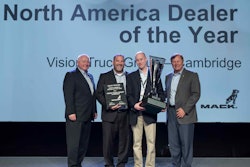
Note: This special report was published by Big Iron Dealer‘s sister news outlet on the commercial truck side, Successful Dealer. While the details included in this report are specific to commercial truck dealerships, some of the takeaways can be applied across multiple dealership industries. This article is Part III of a three-part series. To read Part II, please CLICK HERE.
The last major hurdle in an acquisition is the seller approving the updated offer price. This can be especially daunting when a price has dropped.
For purchasers, it is important to supplement these changes with an explanation and evidence to support such a decision. Then it’s best to step away and allow the seller to decide.
A purchase agreement may be altered any number of times by both sides until compromises are reached and the document is formally approved. Once it is finalized and OEM approval has been granted, the transaction begins galloping toward the finish line.
This is a busy period for a purchaser.
In addition to finalizing all corporate, legal and financial documents, a purchaser also must develop and implement plans to absorb the acquired company into its business.
These plans include but are not limited to vehicle and parts inventory management, business software integration and updating its management structure.
“This is when your start working toward a smooth transition for all of your departments,” says Fenn. “There is a lot to be done. It takes a tremendous amount of coordination and planning with both the buying and selling dealers. [Corporate] processes culture, processes, policies and DMS setups have to be transferred to the new locations, just to name a few.”
A purchaser’s executive team should manage this period, looping in department and middle management as necessary.
“Our entire senior leadership team is involved on our acquisition team,” says Tallman. “They all have a responsibility they must complete and they are alerted pretty early on [during an acquisition] so they know what is coming.”
But upper management are not the only employees that need to be alerted to an acquisition.
A purchasing company should notify its existing employees of an acquisition on or around the official transaction date, and should supplement that news with any information related to changes to their responsibilities and daily tasks.
New employees must be notified as well, and Fenn says how an acquiring company introduces itself to its new employees can go a long way toward the success of the transaction.
In his past life as a dealer executive, Fenn says his business would host a “getting to know you” dinner for its new employees. During the dinner, the Dealer Principal, Fenn and his colleagues would introduce themselves and their company, and lay out the process in which the attendees would be integrated into their business.
Fenn says the presentation served not only to brief the new employees on if and how their jobs would be changing, but also provided assurance that their positions and careers were safe with their new employer.
“We wanted them to know everything was going to be OK,” he says.
Hefner says he and the team and RWC like to visit a newly acquired location a few weeks before a transaction is official and do the same thing.
“We want them to know how important they are to the operation, and share our vision for the company and the market,” he says.
These meetings also can serve to create dialogue streams for future interactions, which are especially valuable once a transaction is official. Employees need to know who they’re working for, and who to go to when they have a question or suggestion.
Allison says he’s worked on acquisitions where the new dealer principal sat down with every new employee to personally introduce himself deliver his vision.
“He wanted his employees to have that connection. ‘Here’s who I am and here’s how I want to do business,’” Allison says.
It’s also at this point when an acquisition can finally meet the public eye. Formal news releases and customer notices should be sent out by a purchaser on the date a transaction is finalized. The latter also should feature any accounting or invoicing changes due to the acquisition.
As for operational changeover, Hefner says purchasers shouldn’t try to do too much too fast.
“You can’t just flip a switch on Day 1,” he says. For a facility that’s operated under one set of parameters for many years, Hefner says its best to start slowly with easily digestible changes, building to larger alterations when new employees are ready to take on the challenge.
Because, ultimately, that’s how a transaction is defined. Not by the speed or efficiency of a sale, but by the long-term success of the acquisition. And that can’t happen without employee commitment.
“You want to get the people to buy in,” says Allison. “That’s what makes it all work.”













